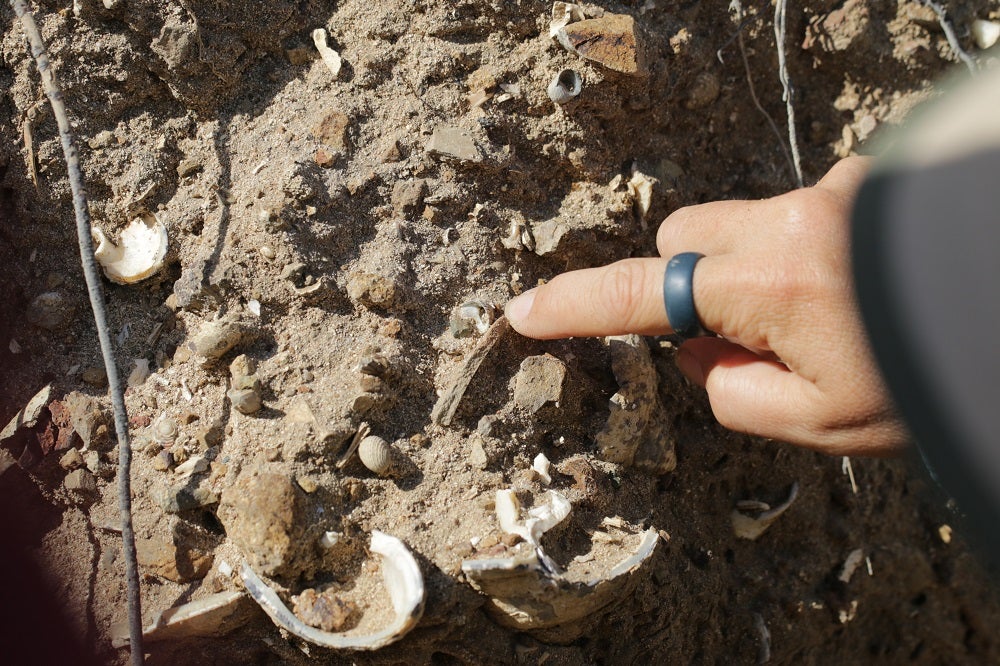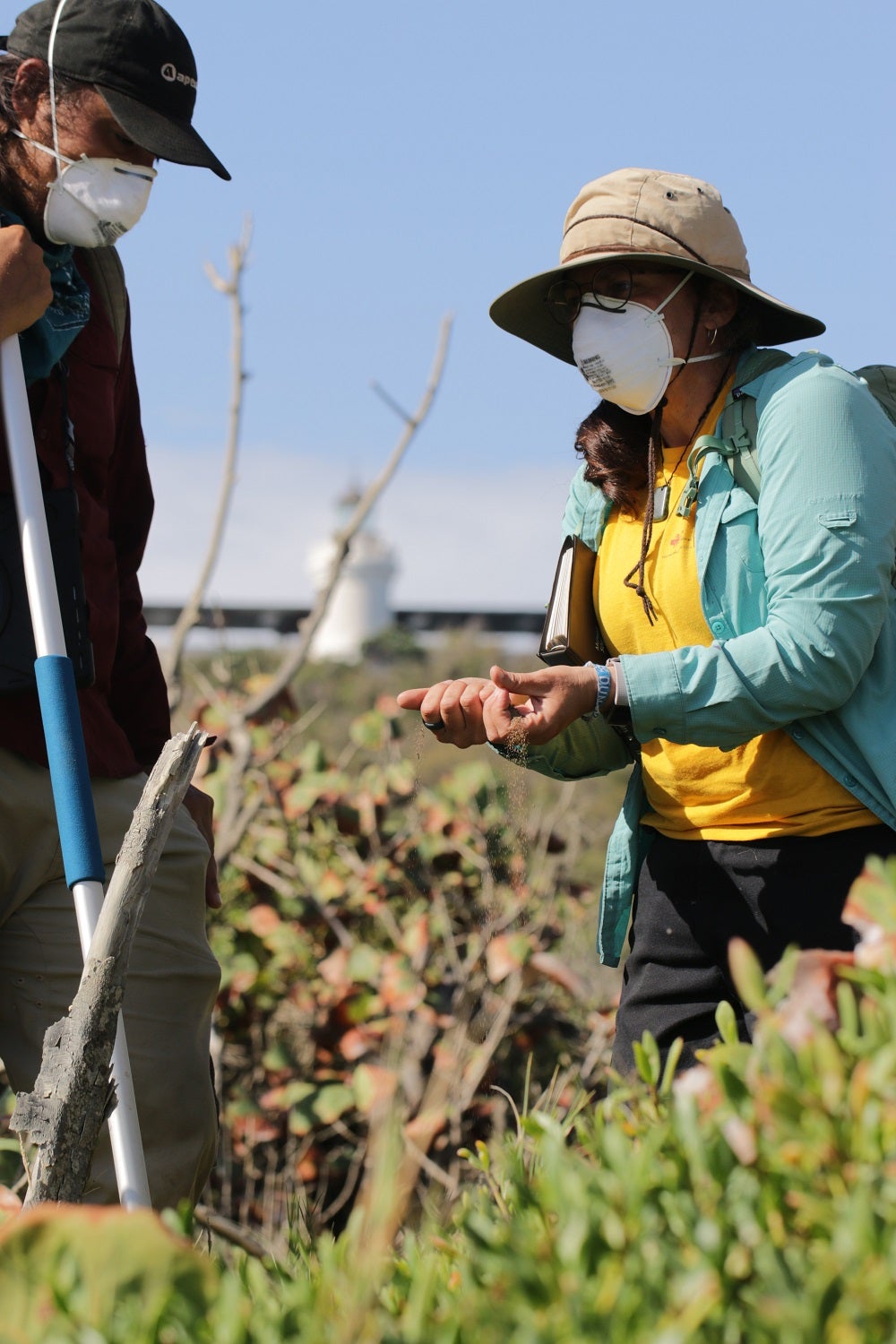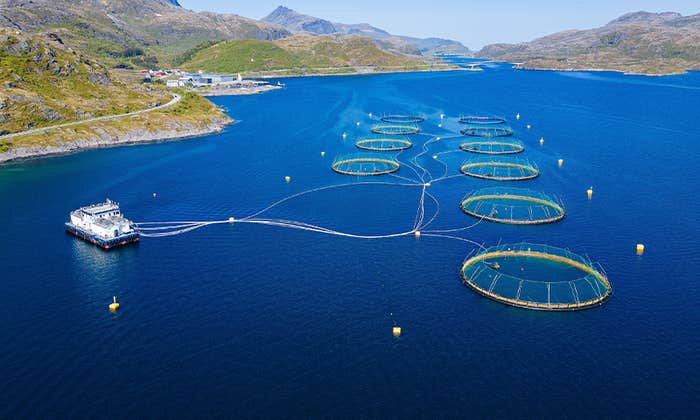This past March, Isabel Rivera-Collazo was taking a walk along a stretch of rocky beach on Puerto Rico’s northern coast when she noticed the telltale sign of a fresh water line. The area—which Rivera-Collazo is reluctant to describe in too much detail, fearing potential looters—is not far from Playa Machuca, where the sand turns a silty black and surfers brave rough waters.
Here is where centuries ago, before the violent arrival of Spanish conquistadors, indigenous people built sacred ceremonial plazas known as bateyes. These bateyes hummed with activity, the locus of trade and travelers coming by sea and by river. Now, as far as Rivera-Collazo knows, this is the only surviving archaeological site on the island with bateyes, which now appear as sunken areas of varying shapes, their edges marked by earthen mounds. They sit mostly empty, occasionally visited by migrating ducks, as one bateye has filled with seawater. The untrained eye might not see much but buried in sand and rock are historical artifacts like pottery and tools, some dating back centuries before the arrival of the conquistadors.

Rivera-Collazo, an environmental archaeologist at the Scripps Institution of Oceanography in La Jolla, California, is especially interested in how climate and environmental change impact human vulnerability. For her, the issue is personal: As a native Puerto Rican, Rivera-Collazo is acutely aware that coastal areas like this are on the front lines of climate change, and that objects of incalculable historical importance are lost to the ocean with each passing storm. The coast is important, she says, because so much precolonial history not lost to Spanish colonization can be found there. “But climate change is washing away these archaeological sites all the time,” she says. “That’s why we are so adamant and in such a hurry to document them.”
Devastating storms now crash into the island almost every year. Four years ago, Hurricanes Maria and Irma pummeled Puerto Rico with 20-foot-high waves and wind speeds over 150 miles an hour. These powerful storms caused thousands of deaths in Puerto Rico alone, and more than $100 billion in property and infrastructure damage, as well as substantial erosion to many coastal regions. And since the island’s coastal areas have borne far less scrutiny than comparable regions in wealthier nations, where archaeologists have largely documented historical artifacts, “we don’t know how much we’ve already lost,” says Rivera-Collazo.
Every major storm destroys ancestral links or whisks them into the ocean forever.
These bateyes are among many coastal areas of archaeological significance in the Caribbean and around the world that are quickly disappearing, via erosion and flooding ramped up by climate change. Through recent field research, Rivera-Collazo and her team have identified at least 47 vulnerable sites along Puerto Rico’s coasts alone, many believed to contain other historical artifacts. Such objects might seem trivial when compared to the staggering potential impact of climate change around the world, but without them, Rivera-Collazo suggests, we lose an already tenuous connection to the Taíno and the pre-colonial period in general. Considering how little the island’s coasts have been documented and how many unknown artifacts may lie beneath the ground, it’s likely that every major storm destroys some of those ancestral links or whisks them into the ocean forever.

These sites also constitute a largely ignored aspect of environmental justice: an implicit acknowledgment that the historical and cultural heritage of Indigenous communities and of people of color are less important than that of wealthy white nations.
History at Stake
Some history books claim the native Taíno population was wiped out when Spanish conquistadors, led by explorer and conquistador Juan Ponce de León, arrived on the island’s northern coast over 500 years ago. Others give short shrift to the Taíno, describing Ponce de León as the person who “discovered” Puerto Rico. But recent scholarship suggests that some Taíno survived the Spanish invasion, while others fled and thrived on nearby islands. In addition to archaeological evidence, a 2018 study reveals that Taíno genes are common throughout the Caribbean, especially in Puerto Rico. But many present-day Puerto Ricans with Taíno blood aren’t aware of their ancestry or of their connections to a distinct culture that predates Ponce de León, Rivera-Collazo says. She sees as part of her job reviving links to these ancestors.
Archaeologists generally refer to ancient artifacts, relics, documents, and structures as “cultural heritage.” But cultural heritage involves more than just a few tangible objects one might observe in a museum. “People sometimes think cultural heritage is this esoteric thing: maybe it’s nice to have it, but if it washes away, is it really that big of a deal?” says Kristina Douglass, an archaeologist at Penn State University. “But anywhere people have stewarded the land and the landscape and created a human niche, as it were, is a place that contains information and stories that are vital to communities today.”

In storm-battered islands and coastal areas often inhabited by poor, Indigenous people, the archaeologists trying to preserve cultural heritage also have to contend with tourism and development, which goes unchecked in many places in the Caribbean, including in spots that researchers haven’t had the chance to survey yet, says Sophia Perdikaris, an environmental archaeologist at the University of Nebraska who focuses on Barbuda island, east of Puerto Rico. “Ultimately, once a bulldozer goes in, you will never be able to recover what was there,” she says.
A similar issue is unfolding in Madagascar, Douglass says. When pitted against rapid development activity, such as the construction of new roads, mining, and logging, culturally important archaeological sites often lose out. “Unless archaeologists and communities work together to bring awareness to the value of these places, they will continue to be destroyed at an alarming rate,” says Douglass.
Black Lives Matter has highlighted issues within archaeology—namely, how racial inequities dictate what’s deemed worthy of saving.
![Kristina Douglas-Portrait 3[6]](https://assets.nautil.us/nautilus-vertical/oceans_c81a415cf7863584f64970b0834c8651.jpeg)
The potential loss of cultural heritage also overlaps with issues of environmental justice, which seeks to address the fact that climate change disproportionately impacts people of color. Climate change-driven erosion threatens Playa Machuca and numerous other places important to native peoples along Puerto Rico’s coasts, while statues of Ponce de León and Christopher Columbus on the northern edge of the island are set further inland and are thus not at risk. On the East Coast of the continental United States, on Virginia’s coast, climate change threatens Jamestown, the first permanent English settlement and the site of the first representative legislative assembly in North America, but the area benefits from more and better-funded archaeologists, who have painstakingly documented the site.
While archaeologists have been aware of climate risks to key coastal sites for years, the Black Lives Matter movement has highlighted issues within the field—namely, how racism and racial inequities dictate what is deemed worthy of saving. This plays out in who gets funding and for what projects and has become a hot topic in archaeology, says Douglass. “I would argue that we haven’t come as far as we need to, not by a long shot, both in terms of conversations about making the professional field more inclusive and centering the work of archaeologists on living communities,” she says.
Rivera-Collazo echoes this point, saying that while archaeologists coming from outside Puerto Rico mean well, it seems as if some just parachute in Indiana Jones-style, do their work, write a report, and leave. Instead, she makes a case for community archaeology, where researchers learn from local communities who have their own knowledge to share and have their own interests and priorities, which sometimes differ from those of non-native scientists.
Rivera-Collazo says that it’s possible to survey coastal sites while collaborating with local communities, by documenting and determining what’s valuable from a cultural heritage perspective. That means developing a clear process where those communities explicitly have a say in how climate-related interventions are done and which sites get prioritized. Institutions like the National Park Service’s National Register for Historic Places and UNESCO’s World Heritage Committee have yet to explicitly and seriously consider input from local residents that way, she says.
For Rivera-Collazo, more than her career is at stake—it’s her history, too. For years, she worked on the island, which she sometimes refers to by its Taíno name, Borikén. (“Puerto Rico,” on the other hand, means “rich port” in Spanish.) “It makes all the difference when you are native and work with your own community,” she says. “It gives you a completely different perspective.” During one recent excavation, her team was visited by Indigenous elders, who in a ceremony displayed and blew their fotuto, a traditional conch shell horn. They blessed her project, and as the sound bounced back from the mountains, Rivera-Collazo says, it felt like she could hear the echoes of history itself.
Archaeologists and Activism
Archaeologists have a unique vantage point, as they study society and history on such a vast scale. This also tends to make them all too aware of the unprecedented nature of current climate impacts. “Archaeologists are looking at human lives over the course of the last few millennia, so they have this perspective of seeing intense climate change in the past and recognizing that the changes we’re seeing today are even more intense and happening at a more rapid pace,” Douglass says.
Over the past decade or so, climate change has transformed their work. Many archaeologists now must prepare for frequent disasters, prioritize the range of threatened sites and artifacts, and try to communicate to whomever will listen about what’s at risk and how urgently people need to respond. “None of us were trained for this work, and it’s now the number one thing we’re doing,” says Sarah Miller, regional director of the Florida Public Archaeology Network. As part of their jobs, archaeologists now struggle to shine the brightest light they can on pressing climate risks, Miller says, including by organizing community engagement programs and informing policy makers and land managers.
“None of us were trained for this work—and it’s now the number one thing we’re doing.”
In the face of worsening climate-driven threats to cultural heritage, Rivera-Collazo and her colleagues have become more outspoken as activists and advocates for preserving irreplaceable archaeological sites and artifacts. They have also turned to professional organizations and regional, national, and international institutions, pushing them to take these issues more seriously. One such organization is the Climate Change Strategies and Archaeological Resources Committee (CCSAR), established by the Society for American Archaeology.
“When you look at the planning that’s being done around climate change and climate justice, archaeology typically tends to be left out of those discussions,” says Carole Nash, an archaeologist at James Madison University and co-chair of CCSAR.
Nash points out that, unlike some other countries, the US doesn’t have a single agency that oversees archaeological resources. She’s also watching how the new bipartisan infrastructure bill is implemented, as it states that new construction should avoid or minimize impacts on sensitive cultural heritage sites. Earlier this year, the Society for American Archaeology publicly supported the National Park Service’s climate change response strategy and Interior Secretary Deb Haaland’s order to protect threatened sites and artifacts—a reversal of a Trump-era policy.
At the international level, Marcy Rockman, an archaeologist at the University of Maryland, helped organize a meeting in December, including experts from the Intergovernmental Panel on Climate Change (IPCC), UNESCO, and the International Council on Monuments and Sites. “Our goal is to help make what is happening to archaeology and other forms of heritage more visible on the global stage, so that the IPCC will say, ‘Yes, cultural heritage is important to us and we recognize its role.’ That’s quite a major step,” she says.
Archaeologists now understand that, in a dramatically changing world, with crumbling coastlines and ever more powerful storms, what worked in the past might not work in the future. Miller and her colleagues face a triage situation in Florida and elsewhere in the Southeastern US, working with the regional group North American Heritage At Risk (NAHAR) to decide as a community which eroding sites they can save and which they have to let go. Some sites, like Pockoy Island Shell Ring Complex on South Carolina’s coast—a Native American site that dates back 4,000 years—are losing land to the sea even during years without hurricanes.

“I think there are misconceptions about what ‘preservation’ means, because at heritage at-risk sites, we can’t preserve the land sometimes,” says Meg Gaillard, an archaeologist with the Heritage Trust Program in South Carolina and NAHAR member. In sites that will disappear within the next 100 years, “‘preservation’ might mean a salvage excavation, as in taking the artifacts out of the ground so that future researchers can analyze them within a collection.”
Archaeologists like Miller and Gaillard are also working closely with museums on emergency evacuation plans, should natural disaster strike. The disastrous fires that razed much of Brazil’s National Museum in 2018 and damaged Paris’s Notre Dame cathedral in 2019 were still fresh in Miller’s mind when she and her colleagues conducted a mock scenario where they had to evacuate a collection in a short period of time. She worked with the Heritage Emergency National Task Force, the Federal Emergency Management Agency (FEMA) and the Smithsonian Institution, trying to account for the fact that during such a scenario, time will likely be very limited. In a crisis—say, 24 hours prior to the arrival of a massive hurricane—they want to be well-equipped to grab the most important or vulnerable collections and deliver them to safety. “If you don’t plan for that and have your volunteers trained, the emotions are so heightened during this exercise, it’s unreal to imagine the day of an emergency. Everybody will be freaking out,” Miller says.
Their work has become a race against time. To better prepare for the climate impacts everyone knows will come, Rivera-Collazo says that archaeologists need to prioritize. “We have to get ready to lose things. Every day it’s washing away,” she warns. “By the time I get funding for Playa Machuca, it will be gone.”
Lead image: Sinkhole in Mayaguez, Puerto Rico. Credit: Sheryl Chapman



































